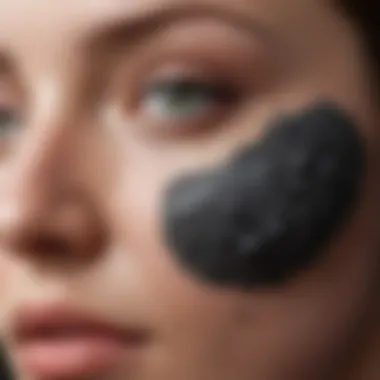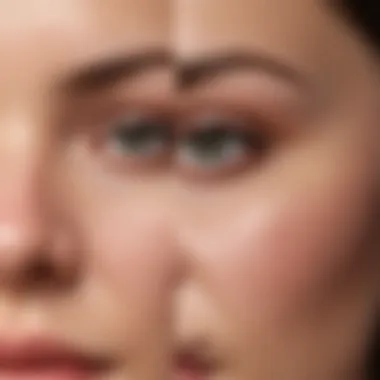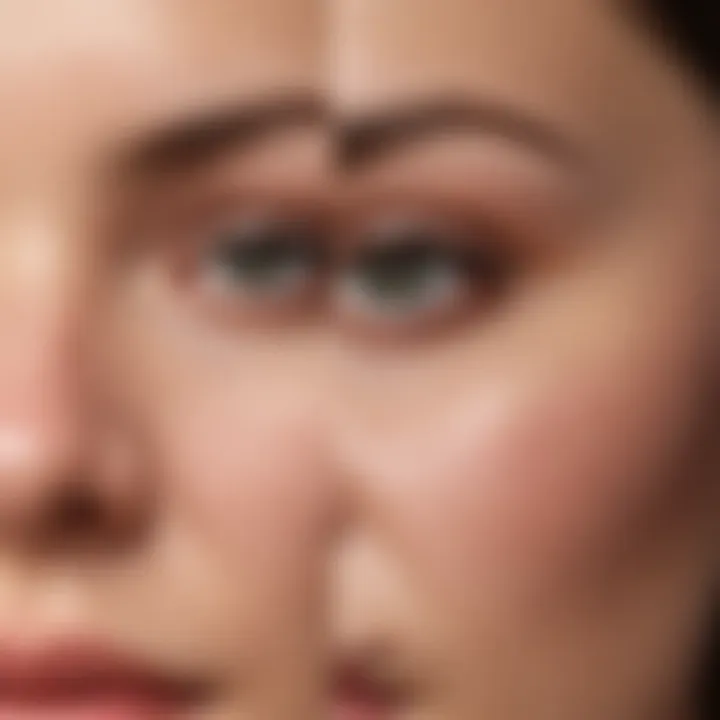Effective Blackhead Removal Products for Your Nose


Intro
Blackheads are a common skin concern. They form when hair follicles become clogged with oil, dead skin, and bacteria. The nose, being an area rich in oil glands, often becomes a hotspot for these pesky blemishes. Many people search for effective blackhead removal products tailored specifically for the nose. This exploration seeks not just to highlight popular products but also to provide an understanding of their ingredients, efficacy, and application methods.
Effective blackhead removal is not merely about quick fixes. It involves a blend of knowledge about skin types, appropriate products, and safe practices. The focus on nose-specific treatments stems from the area’s unique characteristics. While numerous products exist in the market, understanding their ingredients and how they work is crucial for informed choices.
In this comprehensive guide, we will dive deep into various solutions including over-the-counter products and innovative home remedies. The information presented is aimed at empowering women of all ages to enhance their skincare routine with confidence. This article balances the need for clarity with detailed analysis to bring about a more informed approach to managing blackheads on the nose.
Maintenance of clear skin is not just about product choice; it also entails understanding the post-treatment care necessary to sustain results. Different skin types may react differently to certain ingredients, adding another layer to consider when seeking solutions. By peeling back these layers, readers can expect a well-rounded discussion that elucidates blackhead management effectively.
Understanding Blackheads
Understanding blackheads is crucial for anyone looking to improve their skincare routine, specifically regarding facial treatments. Blackheads are a common skin concern that can cause frustration and impact self-esteem. Grasping their nature, formation, and prevention strategies enables individuals to make informed decisions about the most effective removal products.
By exploring the causes and characteristics of blackheads, the reader gains insights into their unique skin needs. This section serves as a foundation for further discussions on effective removal techniques and product choices to achieve clearer skin.
What are Blackheads?
Blackheads are a type of acne known medically as open comedones. They form when oil, dead skin cells, and bacteria clog hair follicles. The main features of blackheads include their small size and dark appearance, which occurs due to oxidation when the clogged material is exposed to air. Unlike other forms of acne, blackheads do not have an inflamed red appearance, making them less noticeable at times, but they can still be a source of concern.
Blackheads can appear anywhere on the body but are most common on the nose, chin, and forehead. This typical location can be attributed to higher concentrations of sebaceous (oil) glands in these areas. Understanding this definition sets the stage for exploring effective solutions for blackhead removal, especially in targeted areas like the nose.
The Anatomy of the Nose
The nose is a complex structure composed of bone, cartilage, and skin. It serves significant functions, including breathing, smelling, and filtering the air. The skin on the nose has unique features that can contribute to the development of blackheads.
The surface of the nose contains numerous pores; these are openings where hair follicles and sebaceous glands exist. These glands produce sebum, which helps moisturize the skin. However, excessive oil production or improper cleansing can lead to clogging. This is particularly relevant in blackhead formation, as the nose is often subjected to higher levels of oil and debris due to its prominent position on the face.
Understanding the anatomy of the nose aids in devising tailored treatments, helping individuals focus their skincare efforts on effective solutions.
Causes of Blackhead Formation
Several factors contribute to the formation of blackheads, and recognizing these can empower individuals to adjust their skincare routines effectively. Here are three primary causes:
- Overproduction of Sebum: Excess oil is the primary culprit behind clogged pores. Factors such as hormonal changes, diet, or genetics can lead to increased sebum production.
- Dead Skin Cells: The natural process of skin shedding can be disrupted. When dead skin cells accumulate instead of being exfoliated, they can mix with sebum and block pores.
- Bacteria: The presence of specific bacteria on the skin can amplify the likelihood of clogged pores. While blackheads themselves are not caused by bacteria, the overall skin health can be affected by their presence.
By understanding these causes, individuals can implement preventive measures. It might include using suitable cleansers, regular exfoliation, and lifestyle adjustments. This knowledge is vital as it informs future decisions regarding product usage and skincare methods, thus contributing to more effective blackhead removal.
Types of Blackhead Removal Products
Understanding the various types of blackhead removal products is essential for anyone seeking clear skin. Each product serves a specific purpose and is formulated with unique ingredients designed to tackle blackheads effectively. Knowing these differences can help consumers choose the right approach based on individual skin types and preferences. Furthermore, certain products may offer immediate, visible results, while others promote long-term skin health. Awareness of the options available enhances decision-making, ensuring that individuals invest in products that address their specific concerns.
Cleansing Scrubs
Cleansing scrubs are often the first line of defense against blackheads. These products usually contain physically abrasive ingredients such as sugar or salt. The intention is to gently exfoliate the skin, removing dead skin cells and impurities that can clog pores. The mechanical action of scrubbing helps dislodge existing blackheads and prevents the formation of new ones.
A primary benefit of cleansing scrubs is their ease of use. Most scrubs can be incorporated into a daily skincare routine, promoting regular exfoliation. However, it’s crucial for users to choose scrubs that are not too harsh. Over-exfoliation can lead to irritation, redness, or even enhanced oil production, worsening blackhead issues in the long run. For best results, those with sensitive skin should opt for a gentle scrub formulated with softer particles.
Chemical Exfoliants
Chemical exfoliants represent a more nuanced approach to blackhead removal. Unlike physical scrubs, these products use active ingredients to promote skin cell turnover. The most noteworthy chemical exfoliants for blackhead removal are alpha-hydroxy acids (AHAs) and beta-hydroxy acids (BHAs), with salicylic acid being a prime example of the latter.
Salicylic acid penetrates the pores, breaking down the bonds holding dead skin cells together. This action not only exfoliates the skin surface but also cleans out the pores deeply. Users often notice a reduction in blackheads and an overall improvement in skin texture over time. When selecting chemical exfoliants, it is essential to follow the instructions carefully, as misuse can lead to irritation or excessive dryness.
Pore Strips
Pore strips offer a quick solution for those seeking immediate results. These adhesive strips are designed to adhere to the skin and pull out impurities, including blackheads, when removed. While pore strips can provide a satisfying visual result, they are more of a temporary fix than a long-term solution.
Users should note that pore strips do not prevent blackheads from forming; they merely remove existing ones. Overuse can also lead to skin damage, as the adhesive may strip too much of the skin’s natural oils. Therefore, pore strips should be used sparingly and should not replace regular cleansing and exfoliating routines.
Peeling Masks
Peeling masks are another effective product for blackhead removal. These masks often contain a blend of exfoliating acids and other active ingredients, designed to be applied in a thick layer and peeled off after a specified time. When removed, they take along dead skin cells and impurities, including blackheads.
The appeal of peeling masks lies in their dual action: they provide exfoliation while also hydrating the skin. However, it is crucial to observe the recommended usage. Frequent application can lead to skin sensitivity or irritation. Selecting a mask suitable for one’s skin type is also important to avoid adverse effects. With careful application, peeling masks can contribute positively to blackhead reduction.
Key Ingredients in Blackhead Removal
Understanding the key ingredients in blackhead removal products is crucial for achieving clearer skin. Each ingredient plays a specific role in targeting blackheads effectively, and knowing these roles can help consumers make educated decisions about which products to choose.
Salicylic Acid


Salicylic acid is widely recognized as a powerful exfoliant. It penetrates into the pores, effectively dissolving the debris that leads to blackhead formation. This ingredient works by breaking down the bonds that hold dead skin cells together, facilitating easier removal of impurities. Its anti-inflammatory properties also help reduce the redness and swelling often associated with clogged pores.
Users with oily or combination skin types often find salicylic acid particularly beneficial, as it can help in controlling excess sebum production. However, it is essential to note that individuals with sensitive skin may experience some irritation. Therefore, starting with lower concentrations is advisable for these users.
Benzoyl Peroxide
Benzoyl peroxide is another ingredient frequently used in acne treatment products. Its primary function is to kill bacteria that contribute to acne and blackheads. By introducing oxygen into the pores, it helps to eliminate the anaerobic bacteria responsible for breakouts. This ingredient also acts as a mild exfoliant, promoting the turnover of skin cells.
It is important to use benzoyl peroxide carefully, as it can be drying. Users should consider their skin type and possibly start with lower concentrations to gauge tolerance.
Charcoal
Charcoal is known for its ability to absorb impurities. Used in masks and scrubs, activated charcoal binds to excess oil and dirt within the pores. It is especially effective in pulling out impurities, making it a popular choice in products aimed at blackhead removal.
While charcoal can be beneficial, it may not provide the deep-cleansing effect that other chemical ingredients offer. Thus, combination use with products that contain acids or enzymes may yield better results.
Retinoids
Retinoids, derivatives of vitamin A, promote skin cell turnover and improve skin texture. They help prevent the formation of blackheads by preventing dead skin cells from clogging the pores. Additionally, retinoids can also reduce the appearance of existing blackheads over time.
As with other active ingredients, retinoids can cause irritation initially. It is advisable to apply them in moderation and to gradually increase the frequency of use. Users should also consider using a good moisturizer to mitigate potential dryness.
Considerations Before Use
Before diving into the realm of blackhead removal products, it is crucial to consider several factors. Understanding these considerations allows individuals to select appropriate products tailored to their skin type and condition. The wrong choice can worsen skin issues, leading to irritation or allergic reactions. Thus, assessing one's needs and circumstances becomes paramount.
Skin Type Assessment
The first essential step in using blackhead removal products is understanding skin type. Different skin types react uniquely to ingredients and formulations. For example, individuals with oily skin may benefit from products with salicylic acid, known for its ability to penetrate oil and clear out pores. Conversely, those with dry or sensitive skin might prefer gentler alternatives to avoid irritation.
To properly assess skin type, individuals should:
- Identify skin condition: Observe how skin behaves in different environments. Is it oily, dry, or combination?
- Consider sensitivity: Determine if skin reacts to common products or environmental factors.
- Consult with a dermatologist: For problematic skin, professional advice ensures appropriate treatment options are considered.
Patch Testing
Once skin type is determined, patch testing is an invaluable step. This practice helps avoid adverse reactions by applying a small amount of the product to a discrete area, usually the inside of the wrist or behind the ear. Here’s how to conduct effective patch testing:
- Apply a small amount: A dime-sized dot should suffice.
- Wait for 24-48 hours: Observe any reactions such as redness, itching, or irritation.
- Assess results: If there are no adverse effects, it’s generally safe to proceed with use.
Patch testing not only protects sensitive skin but also builds confidence in product safety.
Allergies and Skin Conditions
Another key consideration is the presence of allergies or existing skin conditions. Individuals with a history of allergies should examine ingredient lists meticulously. Common allergens in skin products include fragrances, parabens, and certain alcohols. Being aware of these elements can help prevent unwanted reactions.
Additionally, individuals with conditions such as eczema or rosacea should seek products compatible with their skin needs. A healthcare professional's guidance is invaluable.
In summary, prior to using blackhead removal products, careful assessment of skin type, performing patch tests, and recognizing allergies or existing conditions is essential. Taking these steps can lead to safer and more effective results. Understanding these aspects enables individuals to choose the right strategies for clearer skin.
Application Techniques
Application techniques are critical in ensuring the effectiveness of blackhead removal products. Proper method influences not only the removal success but also skin health post-treatment. Using the right technique minimizes potential irritation and enhances product absorption, allowing active ingredients to work more effectively. Therefore, understanding the steps and considerations involved in applying these products can lead to better outcomes.
Step-by-Step Guide
- Start with Clean Skin: Always begin by cleansing your face with a gentle cleanser. This helps remove surface oil and dirt, which enhances the effectiveness of blackhead removal products.
- Examine Your Skin: Know your skin type. Oily skin may require a different approach than dry or sensitive skin. This ensures you choose the right products and techniques.
- Apply the Product: Use a small amount of the chosen product. If it is a scrub, massage it gently onto the nose in circular motions. For chemical exfoliants or masks, follow the package instructions on how to apply evenly.
- Let It Sit: Follow guidelines regarding how long to leave the product on your skin. Chemical treatments usually require a set time for effectiveness.
- Rinse Thoroughly: After waiting, rinse your face well with lukewarm water. Make sure no residue remains to avoid irritation.
- Pat Dry: Use a clean, soft towel to pat your skin dry. Rubbing can cause irritation or exacerbate existing skin issues.
Aftercare Practices
Aftercare is as vital as the application process. Implementing proper practices helps maintain clear skin while preventing dark pores from returning.
- Moisturize: Use a gentle, non-comedogenic moisturizer after treatment. This helps restore skin moisture without clogging pores.
- Use Sunscreen: Always apply sunscreen before stepping outside, especially if chemical exfoliants were used. The skin can be more sensitive to UV rays post-treatment.
- Avoid Heavy Makeup: Try to minimize makeup use for at least 24 hours to allow the skin to breathe and recover.
- Incorporate Regular Exfoliation: Consider adding gentle exfoliation into your routine a few times a week to prevent pore clogging.
- Monitor Skin Condition: Observe how your skin reacts in the days following treatment. If any irritation occurs, temporarily stop using the product and consult a dermatologist.
Potential Risks and Side Effects
Understanding the potential risks and side effects associated with blackhead removal products is essential for anyone considering their use. This aspect is critical in ensuring that users do not inadvertently harm their skin while seeking to achieve clearer pores. The science behind each product varies, and not every product is suitable for all skin types. Knowledge of the potential adverse effects empowers individuals to make informed choices regarding their skincare routines.
Skin Irritation
Skin irritation is one of the most common issues that arise from blackhead removal products. Ingredients like salicylic acid or benzoyl peroxide, often used for their effectiveness, can irritate sensitive skin. Signs of irritation include redness, burning, or a stinging sensation. It is essential to know your skin type to choose appropriate products that minimize this risk.
To reduce the chances of experiencing irritation:


- Start with milder formulas: Use products with lower concentrations of active ingredients, especially if you have sensitive skin.
- Limit frequency of use: Applying products too frequently can exacerbate irritation.
- Monitor your skin's response: Pay attention to how your skin reacts after applying a new product.
Allergic Reactions
Allergic reactions to blackhead removal products can occur, though they are relatively rare. Ingredients such as fragrances or preservatives can trigger such reactions. Symptoms might include itching, swelling, or hives. Individuals with known allergies to certain compounds should carefully read labels and avoid those products.
If a reaction occurs:
- Immediately stop using the product.
- Consult a healthcare provider for advice on how to treat the symptoms.
- Perform patch testing before extensive use to identify potential allergies. A patch test involves applying a small amount of the product to a discreet skin area and observing for any adverse reactions.
Long-Term Effects
While quick fixes can be tempting, users must consider the long-term effects of regular blackhead removal. Overuse of harsh products can lead to skin barrier damage, causing dryness and increased sensitivity. Long-term users may also find themselves developing skin issues such as increased acne or scarring due to aggressive extraction techniques.
To mitigate these risks:
- Balance your skincare routine: Incorporate hydrating products and sun protection.
- Rotate your products: Instead of using the same strong product daily, alternate with gentler options.
- Consult a dermatologist for personalized guidance on effective and safe strategies for managing blackheads over time.
Keeping informed about the potential risks and side effects of blackhead removal products helps achieve healthier, clearer skin without compromising skin integrity.
Natural Remedies for Blackhead Removal
Natural remedies for blackhead removal offer a gentle and often effective approach. Many individuals are increasingly seeking solutions that come from nature, looking to avoid harsh chemicals found in some over-the-counter products. Natural treatments can often provide nourishment for the skin while addressing congestion in the pores.
Key benefits of using natural remedies include:
- Gentleness on the skin, reducing the risk of irritation.
- Accessibility, as many ingredients can be found in your kitchen.
- Cost-effectiveness, since most natural ingredients are affordable.
However, it is crucial to consider the skin's unique needs. Different skin types may react variably, even to natural substances. Therefore, consistency and patch testing before applying any remedy is advised.
Exfoliating Options
Exfoliating options play a significant role in blackhead removal. Natural exfoliants include items such as coffee grounds, oatmeal, and sugar. These ingredients can help slough away dead skin cells and impurities, minimizing the chance of clogged pores.
**How to use: **
- Combine the exfoliant with a natural oil like coconut or olive oil for added moisture.
- Gently massage the mixture onto the nose in circular motions.
- Rinse with lukewarm water.
- Follow with a moisturizer to maintain skin hydration.
It's recommended to exfoliate no more than two to three times a week to prevent overstressing the skin.
Clay Masks
Clay masks are known for their detoxifying properties. Clay, such as bentonite or kaolin, can absorb excess oil and draw out impurities. This makes them particularly beneficial for those prone to blackheads.
Benefits of Clay Masks:
- Help control excess oil production.
- Remove toxins from the skin.
- Tighten pores
To apply, simply mix the clay with water or apple cider vinegar until a paste forms, applying it to the nose and allowing it to dry. After 10-15 minutes, gently rinse off. This practice can be done once a week depending on skin sensitivity.
Honey Treatments
Honey is another powerful natural remedy for blackhead removal. Its antimicrobial properties make it effective in combating bacteria that can lead to breakouts. Additionally, honey helps moisturize the skin, which is beneficial in maintaining balance.
How to use Honey for Blackheads:
- Apply raw honey to the affected areas.
- Leave it on for approximately 15-20 minutes.
- Rinse with warm water.
Regular use of honey treatments can lead to smoother skin and minimized pore appearance. This method is suitable for most skin types.
Natural remedies can be both effective and kinder on the skin. However, individual results may vary.
Professional Treatments for Blackhead Removal
Professional treatments for blackhead removal offer a range of options designed to provide deeper and more effective cleansing than many over-the-counter products. In a world where skin health is highly prioritized, understanding these accessible and often more potent options becomes crucial. The benefits of these treatments include the immediate visible reduction of blackheads, personalized care from skincare professionals, and lower risk of irritation. This section will explore three significant methods of professional treatment: facials, microdermabrasion, and chemical peels.
Facials
Facials are a popular choice for blackhead removal. During a facial, a trained aesthetician assesses the client’s skin type and condition before selecting specific products. They may use systematic steaming to loosen debris and soften the skin. Extra steps often include gentle exfoliation and the manual extraction of blackheads.
Facials not only address blackheads but also enhance overall skin health. Regular facial treatments can lead to improved skin texture and tone. Moreover, the soothing environment of a facial session offers relaxation, creating a beneficial experience for both skin and mind.


Microdermabrasion
Microdermabrasion is a more advanced option that employs a minimally abrasive instrument to gently sand the skin. The process aims to remove the outer layer of dead skin cells while promoting new cell growth.
This treatment is effective for reducing blackheads as it clears clogged pores and improves skin texture. Multiple sessions often yield the best results. Patients typically appreciate the little downtime involved, as most can return to their daily activities without visible signs of treatment.
Chemical Peels
Chemical peels are another effective method for blackhead removal. This treatment involves applying a solution to the skin that exfoliates and eventually peels away layers of skin. Depending on the depth and type of peel selected—light, medium, or deep—the results can range from mild to profound, addressing issues such as blackheads and other types of blemishes.
Light peels may use alphahydroxy acids, providing superficial exfoliation with minimal recovery time, while deeper peels often require more extensive aftercare. Each type of peel presents unique benefits and risks, making consultation with a skincare professional essential.
In summary, professional treatments for blackhead removal represent effective solutions for individuals dealing with persistent issues. Facials, microdermabrasion, and chemical peels are valuable options that can enhance skin clarity and health while addressing the root cause of blackheads.
Evaluating Product Effectiveness
Evaluating the effectiveness of blackhead removal products is a critical step in ensuring you choose the right solution for your skin. Gaining a clear understanding of how these products perform can greatly influence one’s purchasing decisions and overall satisfaction. This section explores essential elements such as user feedback, clinical studies, and other aspects that contribute to determining product efficacy.
Reviewing User Feedback
User feedback plays a crucial role in assessing how well a blackhead removal product meets its promises. When individuals share their experiences, it offers insights into real-life outcomes beyond what the packaging may state. Reviews often highlight several beneficial aspects, including ease of use, visibility of results, and skin reactions.
- Pros of User Feedback:
- Provides practical examples of product effectiveness.
- Highlights specific features that may work well or poorly for different skin types.
- Can reveal any unexpected results or side effects encountered.
In addition to individual reviews, aggregating user feedback from various sources can lead to a more comprehensive understanding. Websites like Reddit or beauty forums can provide a platform for users to discuss their real-life experiences, making it easier to gauge how products perform on average. However, it’s essential to consider the overall consensus rather than rely solely on one or two opinions.
"What works for one person may not work for another, so individual results vary widely."
Clinical Studies
Clinical studies serve as a scientific foundation for evaluating blackhead removal products. These studies are conducted by dermatologists and researchers to objectively assess the effectiveness, safety, and side effects associated with specific treatments. Results from clinical trials can shed light on the efficacy of key ingredients and application methods.
- Importance of Clinical Studies:
- Provides validation through controlled testing and research.
- Can demonstrate statistically significant improvements in skin conditions.
- Helps identify potential side effects that may not appear in user reviews.
Incorporating findings from clinical studies can elevate a product’s credibility. For instance, a product that contains salicylic acid and is backed by clinical research showing its effectiveness in removing blackheads can encourage consumers to trust its efficacy.
Both user feedback and clinical studies form a comprehensive approach to evaluating product effectiveness. While personal experiences can provide relatable insights, scientific backing adds an important layer of credibility. This blend of data assists consumers in making informed decisions, ultimately leading to better outcomes in their blackhead removal efforts.
Environmental Considerations
Understanding the environmental aspects of blackhead removal products is crucial in today's eco-conscious society. Consumer awareness regarding environmental impact drives the demand for products that prioritize sustainability and ecological integrity. This section aims to shed light on the significance of these considerations in formulating blackhead removal solutions, while also presenting insights on the benefits and practices that can enhance our connection to the planet.
Sustainability in Product Design
Sustainability in product design refers to the creation of items that are environmentally friendly, yet effective. It involves considering the entire lifecycle of a product, from sourcing raw materials to packaging and disposal. For blackhead removal products, this means utilizing materials that do not harm the environment. Brands can address sustainability in various ways:
- Material Selection: Opting for biodegradable or recyclable materials for packaging reduces landfill waste.
- Resource Efficiency: Utilizing ingredients that require fewer resources to produce, such as certain plant-based extracts, lessens their ecological footprint.
- Production Techniques: Employing eco-friendly manufacturing processes minimizes waste and energy consumption.
The shift toward sustainable design not only aligns with environmental responsibility but also enhances brand loyalty among informed consumers. This creates a win-win scenario for both the planet and businesses, leading to products with a lower impact.
Eco-Friendly Ingredients
The ingredients used in blackhead removal products play a significant role in their environmental impact. Eco-friendly ingredients are those that are sourced sustainably and do not contribute to ecological degradation. Options include:
- Plant Extracts: Ingredients derived from plants that are grown without pesticides or synthetic fertilizers.
- Natural Clays: Such as bentonite, which can be sourced responsibly and offer effective cleansing properties.
- Organic Oils: Oils that come from ethically sourced crops help in nourishing the skin without harmful residues.
Choosing products with eco-friendly ingredients is essential for those who are concerned about both skin health and environmental protection. The use of these ingredients promotes biodiversity and helps to protect vital ecosystems. Additionally, the demand for eco-friendly formulations is driving innovation in the beauty industry, encouraging more brands to rethink their ingredient choices.
"The future of beauty relies on harmonizing human needs with the health of our planet."
Future Trends in Blackhead Removal
Understanding the future trends in blackhead removal is essential for consumers seeking effective solutions. The evolution of skincare products, particularly those aimed at blackhead removal, reflects advancements in technology and formulation science. As new challenges arise, such as increasing pollution levels and changing skin types among consumers, it is vital to explore emerging trends that promise better efficacy and user experience.
Technological Innovations
Recent advancements in technology significantly influence the development of blackhead removal products. Smart gadgets are on the rise, providing users with ways to monitor skin condition in real time. For instance, the integration of skin-scanning devices allows for personalized skincare regimens. These gadgets analyze skin type, hydration levels, and sebum production, customizing recommendations based on individual needs.
Additionally, LED therapy devices are becoming more prevalent. These products utilize specific wavelengths of light aimed at reducing bacteria on the skin, which aids in preventing blackhead formation. Another innovation includes ultrasonic skin scrubbers that use high-frequency vibrations to dislodge impurities from pores. This method is less invasive and offers an effective alternative to traditional extraction techniques.
Formulation Developments
As skincare science progresses, formulation innovations play a crucial role in blackhead treatment. The focus is shifting toward lightweight, multifaceted products that combine various active ingredients. New formulations often leverage the synergistic effects of ingredients like salicylic acid, niacinamide, and glycolic acid. These combinations enhance exfoliation, reduce inflammation, and improve skin texture simultaneously.
Moreover, emphasis on non-comedogenic formulas is increasing. Products designed to prevent pore blockage while providing deep cleansing are gaining traction. This trend aligns with a more comprehensive understanding of individual skin conditions, where personalized formulations can address unique needs.



